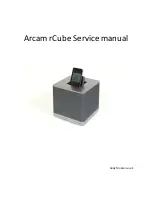
RF
AMP
continue
The
RF
stage
is
both
Receive
or
Transmit
(transceiver)
allowing
Cubes
to
be
linked
for
docked
iPod
source
and
external
analogue
inputs
hence
you
will
see
two
spate
paths
that
are
switched
R.F
switches
seen
as
IC701
IC702
IC703
two
separate
Antenna
are
used
and
the
rCube
has
the
ability
to
select
the
most
stable
aerial
at
any
given
time
the
audio
path
into/out
of
the
Kleer
chip
is
seen
as
KL3012
regardless
of
status
–
when
in
receive
mode
the
RF
power
amp
is
bypassed
by
IC701,
IC702
in
transmission
mode
both
switches
are
toggled
to
bring
the
Saw
filter
FL700
and
Low
RF
Pass
filter
FL701
with
Power
Amp
IC704
back
in
line,
The
two
antenna
are
connected
to
the
surface
mount
sockets
at
SKT700
an
SKT701.
DAC
Filters
and
Amplifiers
Audio
arrive
the
DAC
filters
and
Amplifiers
circuit
from
the
DSP
as
4
separate
channels
these
being
TWEET_L/
TWEET_R/
WOOF_L/
WOOF_R
each
channel
travel
thru
an
identical
filter
circuit
TWEET_L
channel
will
be
described.
TWEET_R
audio
arrive
at
capacitor
C508
before
traveling
into
the
filter
based
around
the
NJM2114
at
location
IC500
the
audio
is
further
filtered
by
the
network
of
capacitors
based
around
C326
and
C327
in
combination
with
C510
–
audio
then
passes
into
the
Volume
control
IC
at
location
IC501
on
pin
1
and
can
be
seen
to
exit
(volume
adjusted)
on
pin
14
–
the
volume
control
is
under
control
of
the
main
micro
at
position
U302
via
line
VOL_CLK
/
VOL_DAT
the
line
will
know
be
known
as
TWEET_VOL_R
and
travels
into
the
Power
amp
chip
at
location
IC507
(shared
with
TWEET_VOL_L)
this
package
is
driven
from
the
+19v_amp
supply
and
is
thermally
protect
to
trigger
at
100c
/
standby
and
mute
control
comes
from
the
main
micro
and
temp
status
of
the
power
amp
can
be
reported
to
back
to
the
micro.
The
WOOF_VOL_L
and
WOOF_VOL_R
audio
paths
use
a
bridged
power
amp
each
seen
at
locations
IC504
and
IC05.
Display
and
keyboard
The
display
board
is
connected
to
the
main
board
via
the
iPod
header
board
and
it’s
primary
link
on
the
main
board
is
main
micro
U301.
The
board
is
built
around
the
IC1
a
AT42QT1060
6
‐
channel
sensor
IC
this
allows
for
capacitive
sensors
as
keys
and
also
perform
the
role
of
driving
the
top
plate
LED’s
with
exception
of
Standby
LED
status
red
(this
comes
directly
from
U301)
the
chip
is
supplied
by
the
3V14
STBY
power
supply,
the
reset
circuit
shown
on
the
circuit
was
not
required
by
the
final
design.
All
LEDs
are
driven
from
the
+5_DIS
rail
apart
from
standby
(red)
as
this
is
on
the
3V14(STBY)
rail.





















